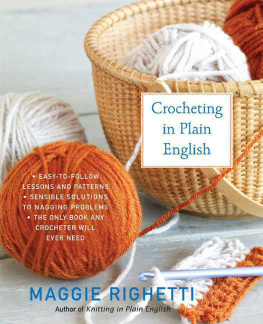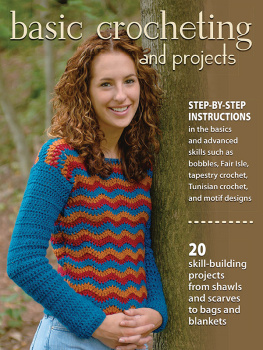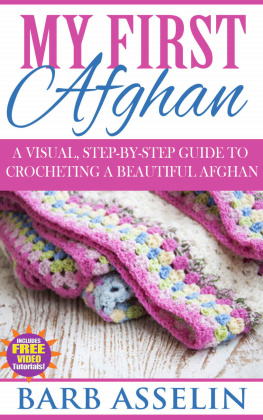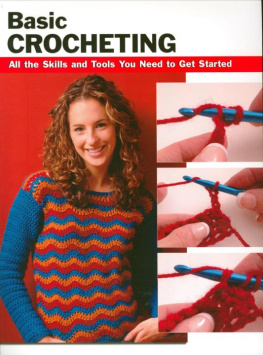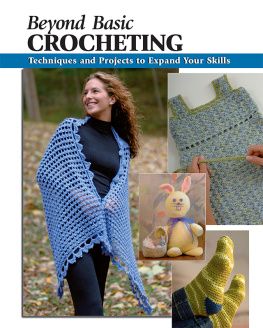Crocheting
in Plain
English
SECOND EDITION
MAGGIE RIGHETTI

The author and publisher have provided this e-book to you for your personal use only. You may not make this e-book publicly available in any way. Copyright infringement is against the law. If you believe the copy of this e-book you are reading infringes on the authors copyright, please notify the publisher at: us.macmillanusa.com/piracy.
To Mary Lee Maury
A daughter God forgot to give me
Acknowledgments
How to thank you all
Let me count the ways
I thank you all to the depth and breadth and height my tired mind can remember.
I thank you all for the foods that you fed me.
Food for the flesh from Roberta Senitzer and Pat Yarborough, and barbecue from Randy.
Food for the soul from Harriett Hartshorn, with hugs and kisses from John.
Food for the growth of the skill of wordsmanship to make clear and explain a complicated thought from Barbara Anderson, Debbie Allen, and the Village Writers critique group of Dudley Hinds.
Food for the craft/art form of crochet from Mary Lee Maury.
In short, without the foods of love and support given me by family, friends, and neighbors, this book wouldnt be in print.
And I cant forget the children of neighbors who walked my dog and watered my plants when I could not.
I thank you all.
Preface
If you have never touched a crochet hook before, if you have made only simple crochet projects, or even if you are a skilled and swift worker of the craft, you will find in this book a wealth of information, filled with creative ways to solve problems and new ideas to speed youand your hookon your way. It is a complete guide to unraveling the secrets of the fine art of crocheting.
Using common sense, plain English, and a sense of humor, I try to make clear the workings of making lace in the air, as the old French name calls it. Crocheting is an easy, relaxing, and rewarding handcraft that should hold no mysteries. All its ins and outs can be revealed simply and clearly. If there seem to be cloudy mists and confusion about crocheting, it is because no one before has taken apart the pieces and put them back together, step by simple logical step, in language that everyone can understand.
Beginning with how to choose a project and the appropriate threads, yarns, and hooks, all the way through to simple and elaborate stitches, putting the completed parts together, and adding eye-catching details, this book will build the readers confidence as the information in each chapter is absorbed. As the crocheter works through the basics, I show how to create variations and think through to other applications. When the crocheter understands the whys and wherefores, he/she can become more proficient and creative.
Crocheting is the conjuring of magic with simple supplies, and it can bring endless joy and delight. This book can take the crocheter from I dont understand and Why did I ever start this stupid thing to I figured it out all by myself and This piece that Im making will become a family heirloom to be treasured for years.
Introduction
A Crochet Teacher Tells All
Not everyone is fortunate enough to have a knowledgeable and kindly crochet teacher. And without one, few people will struggle and stumble along by themselves, hanging on and hanging in, to teach themselves all of the twists and turns of this magic skill. As a teacher with many years of experience in answering students questions and solving their problems, I think I may have seen every possible misunderstanding and misconception concerning crochet. This book is filled with many of the things I have learned, for I truly enjoy helping others avoid needless frustration.
This book is divided into four parts. Part one covers all the things a crocheter needs to be aware of before making a single stitch. Part two covers all those pesky details of working and shaping the newly made fabric into a wondrous creation. Instructions for many different pattern stitches are included here. Part three explains the finishing touches that transform the pieces into a useful article. Part four is composed of learning lessons for the beginning crocheter. These projects are fully explained and may be done alone or in a class with an instructor. Every step of the directions is written in three ways so that the student can read, copy, or think it through.
Finally, the glossary defines terms and untangles the meanings of abbreviations. There is also an index for easy reference.
Because of the way this book is organized, it can be used as a beginners introduction and guidebook, as a skilled crocheters handy reference tool and source of finer points and pattern stitches, and as a text for crochet teachers. My purpose in writing this book is to give confidence, courage, and creativity to crocheters everywhere.
Part One
Before You Begin to Crochet
1
A Living History
I can still remember the first piece of crocheting I ever saw. It was a small yellow doily, surrounded by lavender pansies, in the living room of the parsonage, and my seven- or eight-year-old mind thought that it was the most wonderful creation in the world. They look just like real pansies!
It is only crocheting, sniffed my mother. Come over here and sit down and be quiet.
Not too long after that, I saw a wondrous white lace table centerpiece. It sat like an angels crown, stiffly starched into curved ruffles, in the center of a polished dining room table in a home where we had gone to sell eggs. Look at the beautiful lace, Mama! To a child inured to the grinding poverty of worn-out, mended, and faded artifacts of the Great Depression, it was the loveliest thing I had ever seen.
Hush, child, and mind your manners. It is not real lace; it is only crochet, scolded my mother. Belgian lace is the only real lace, said Mama, who also thought that genuine oil painting was the only real art.
Would you like to touch it, little girl? asked the nameless woman of the house.
No, interrupted Mother. She may not touch anything. Which only made me love the lace more.
And then, for my graduation from the eighth grade, my grandmother in Louisiana sent me a white drawstring bag with bands of inset white roses. Look at the beautiful lace roses, I cried, happy to own something beautiful for myself.
It is only crochet, sniffed my Aunt Martha. Venetian rose point lace is the only real lace.
Undaunted, I asked, Could I learn how to do it?
Poor people do crochet, sniffed my older sister. Fine ladies do needlepoint. But I treasured that white cotton drawstring handbag embellished with roses and vowed that someday I would make lace like that.
For the second daughter of a struggling middle class couple, born in the midst of the Great Depression, that day came sooner than anyone could have imagined. When I was fourteen, I went to work after school and on weekends at the Woolworths 5 and 10 cent on California Street in Huntington Park, California. I worked in a dark corner of the store in the Art Needlework Department (at fifty cents an hour) under the tutelage of a stern and proper woman named Margaret Mines. At the end of the first day she said, Well, if youre going to work here, youre going to have to learn to crochet and to knit. Here She handed me a ball of royal blue Coats and Clark Knit-Cro-Sheen, an instruction book, and a ten-cent steel Boye crochet hook.
I learnedbecause I needed the job. I went home and I struggled, as a young high school student does, with freshman Spanish and first-year algebra and the steel hook and the dark blue thread. It took me a long time to figure out that you have to rotate the throat of the hook down to face the ground in order for the loop to slip off. It seemed that the Spanish alphabet and basic equations (A+B=10) were easier to understand than sc in 2nd ch sk 2, dc in next st

